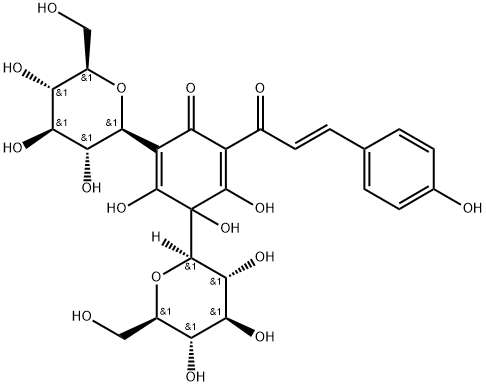SAFETY INFORMATION
| Signal word | Warning |
|---|---|
| Pictogram(s) |
 Exclamation Mark Irritant GHS07 |
| GHS Hazard Statements |
H317:Sensitisation, Skin H319:Serious eye damage/eye irritation |
| Precautionary Statement Codes |
P280:Wear protective gloves/protective clothing/eye protection/face protection. P305+P351+P338:IF IN EYES: Rinse cautiously with water for several minutes. Remove contact lenses, if present and easy to do. Continuerinsing. |
COMPUTED DESCRIPTORS
| Molecular Weight | 612.5 g/mol |
|---|---|
| XLogP3 | -3.5 |
| Hydrogen Bond Donor Count | 12 |
| Hydrogen Bond Acceptor Count | 16 |
| Rotatable Bond Count | 6 |
| Exact Mass | 612.16903493 g/mol |
| Monoisotopic Mass | 612.16903493 g/mol |
| Topological Polar Surface Area | 295 Ų |
| Heavy Atom Count | 43 |
| Formal Charge | 0 |
| Complexity | 1160 |
| Isotope Atom Count | 0 |
| Defined Atom Stereocenter Count | 10 |
| Undefined Atom Stereocenter Count | 1 |
| Defined Bond Stereocenter Count | 2 |
| Undefined Bond Stereocenter Count | 0 |
| Covalently-Bonded Unit Count | 1 |
| Compound Is Canonicalized | Yes |
PRODUCT INTRODUCTION
description
Hydroxysafflor yellow A is a C-glycosyl compound that is 3,4,5-trihydroxycyclohexa-2,5-dien-1-one which is substituted by beta-D-glucosyl groups at positions 2 and 4, and by a p-hydroxycinnamoyl group at position 6. It is the main bioactive compound of a traditional Chinese medicine obtained from safflower (Carthamus tinctorius). It has a role as an anti-inflammatory agent, an antioxidant, a platelet aggregation inhibitor, an antineoplastic agent, a radical scavenger, an EC 3.2.1.48 (sucrose alpha-glucosidase) inhibitor, a neuroprotective agent and a plant metabolite. It is a C-glycosyl compound, a member of phenols, an enone and an enol.

